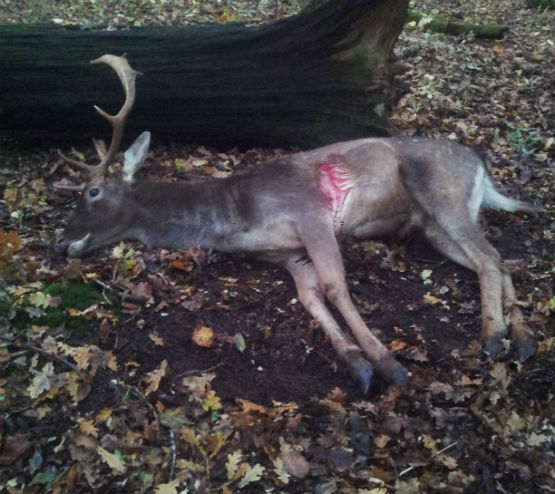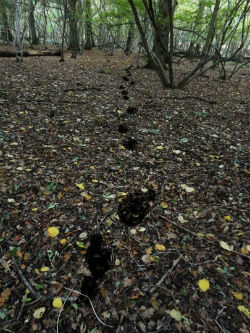Take the anxiety out of your stalking. James Mott considers the different sounds that a bullet makes when striking a deer and why it’s important to listen carefully in order to lower your stress levels.
If you’ve been deer stalking for any length time, you’ll understand that sinking feeling when you’ve taken a shot, walked over to where you shot the deer (or thought you did) only to find – no deer.

(Above: Even shot through the heart, this Fallow Buck made a 100 yard dash before collapsing)
Now the search begins. The deer’s reaction to a shot can vary significantly. Whilst a shot deer will usually drop on the spot, equally they can run some distance, particularly if the deer has seen you before the shot. Pumped with adrenaline, it is not unusual, for a deer shot straight through the heart to run upto 200 yards before collapsing, dead.
Searching an area for the usual signs of a dead deer – blood, hair, bone fragments etc. and finding none after quarter of an hour, leads to a plethora of emotions - anxiety, frustration, doubt about your shooting abilities & concern in case you injured the animal.
I remember many years ago, being invited to stalk on an estate in Hampshire. My friend set me up on the edge of a wood at twilight and went off to sit in a nearby high seat.
 Sure enough a roe doe appeared within a few minutes at a range of 60 yards. Having newly acquired my FAC and having already culled a number of deer, I felt confident in my abilities. I upped my sticks, took aim and fired. I couldn’t miss.
Sure enough a roe doe appeared within a few minutes at a range of 60 yards. Having newly acquired my FAC and having already culled a number of deer, I felt confident in my abilities. I upped my sticks, took aim and fired. I couldn’t miss.
(Left: Before following up it is useful to be able to gauge an idea of where you may have struck your animal)
My friend came over, by which time I had walked to the spot where I thought I had shot the deer , placed my stalking sticks in the ground and had started the search for my deer. “Got ‘im’”? Jeff said as he came over. “I think so” I said “but I can’t find it”
Then came the searching question. “What did the shot sound like”. Scratching my head, I muttered something along the lines of “not sure really” which I was informed, rather testily, was far from a satisfactory answer.
We carried on searching the area for an hour, inch by inch and could find no blood, no hair, nothing.
“It was only 60 yards” I keep saying “it was impossible to miss”.
Initially I was elated – now I had that feeling of impending doom. I couldn’t help it. Doubt crept in – maybe I didn’t hit it at all? What if it was injured? What must my friend think of me? It was a horrible feeling which I remember to this day.
It was now pitch black. We agreed we’d have to come back in the morning and have another search – it is never an option to leave a dead or injured deer, plus if the landowner’s dog found it, he would not be best pleased.
Back early the next morning we searched again - nothing, not a sign.
“Well that’s that” Jeff said, we have done our best, there’s nothing more we can do, “we might as well put a few shots into a target before we go”. So having set up a target, I aimed and fired. No bullet on the target! “Blow me” said Jeff “you must have knocked your scope somehow”. I had, my rifle was shooting 10” high!! I felt instant relief – my shooting was ok, no injured deer, just a pure miss!!
If only I’d paid attention to the sound of the bullet strike, it would have saved a whole lot of time and angst!!
When a bullet strikes a deer, the sound of the strike depends on where the animal has been hit. It takes a bit of practice but it is possible to discern the different sounds on impact. So what are the sounds?
Unfortunately it’s somewhat difficult to describe. Some say it sounds like a whack or a thwack or a thud – you may have your own word to describe it.
To my mind there are 4 different scenarios to consider:
- Clean miss – normal twack sound
- Heart/ lung shot – solid reassuring thump
- Shot hitting bone such as a leg – higher pitched, more of a crack that a thump
- Gut shot – more of a dull thud
My best efforts to describe the sounds on paper are at best inadequate. The only way to learn is to gain experience yourself. Try setting up a target with different objects behind and you will start to tune your ear in to the different sounds a bullet makes on impact with each object.
With a little practice you’ll start to hear the audible sound of a bullet strike on a deer and in the process take away the anxiety often felt after you’ve pulled the trigger.
 (Right: James Mott is an accomplished stalker and new Assistant Stalker at County Deer Stalking)
(Right: James Mott is an accomplished stalker and new Assistant Stalker at County Deer Stalking)



















